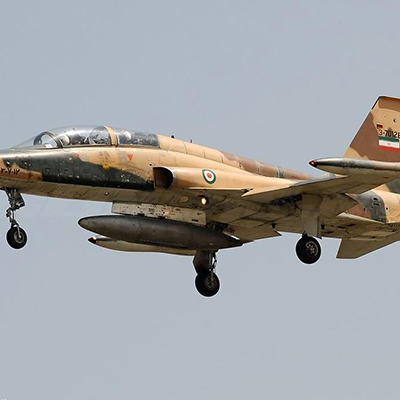Warfare
RF-5
Written by: Mohsen Shirmuhammad,
Translated by: Hadi Qorbanyar
65 دورہ
The RF-5 is a reconnaissance aircraft that was used during the Iran–Iraq War for aerial photography of military targets.
Essentially, the RF-5 is the reconnaissance version of the F-5 fighter jet. When the F-5 aircraft entered service with the Iranian Air Force and proved its operational value, the military commanders, recognizing the need for a modern reconnaissance fighter, decided to purchase the RF-5 in 1968.[1]
The nose section of the RF-5 is equipped with five camera mounts. Due to its limited range and altitude capabilities, the RF-5 is best suited for low-altitude reconnaissance missions. The aircraft can reach a maximum speed of Mach 1.6 (approximately 1,700 km/h), with an operational range of up to 900 kilometers, depending on the payload configuration. It measures approximately 15 meters in length, with a wingspan of 7.5 meters.[2]
Following the tensions between Iran and Iraq over navigation rights in Arvand Rud in 1969 and subsequent border clashes, RF-5 reconnaissance flights were carried out over Iraqi territory. The aircraft was also used in other operations, most notably during the recapture of the three islands in 1971.[3]
By the mid-1970s, the F-5s were gradually replaced by F-16 fighters, and many of them were sold to other countries. For example, two RF-5 aircraft were transferred to Morocco.[4]
With the outbreak of the Iran–Iraq War and the enemy’s advance into Iranian territory, RF-5 aircraft were deployed to conduct reconnaissance missions.[5]
From the second week of the war, as Iraqi forces pushed deeper into southern Iran and aerial photographs were needed to identify their positions, RF-5 aircraft were deployed to Dezful Air Base. At the same time, some were dispatched to Tabriz to support intelligence-gathering efforts focused on northern Iraq.[6] On September 30, 1980, two more RF-5s were stationed at Tabriz Air Base,[7] and two days later, three others were redeployed from Mehrabad to Dezful Air Base.[8]
Early in the war, temporary photo labs were set up at Dezful and Tabriz, enabling the personnel to handle the development, printing, and analysis of reconnaissance photographs on-site.[9] After completing their missions, RF-5 aircraft would land at the 2nd Tactical Air Base (Tabriz) and the 4th Tactical Air Base (Dezful), where the captured images were processed and then sent to ground command posts. Operational decisions were made based on the information extracted by analyzing the photos. For example, during the liberation of Susangerd (November 14–17, 1980), two RF-5 reconnaissance sorties were flown daily from Vahdati Air Base (Dezful).[10]
From the second year of the war onward, the number of RF-5 reconnaissance missions gradually decreased due to their low-altitude flight profile, short camera focal length, and consequently limited coverage area. Meanwhile, given the RF-4’s advanced operational capabilities, this aircraft saw more frequent use. During this period, the RF-5s were employed for air patrol missions instead.
To adapt the RF-5 for patrol missions, external fuel tanks were placed under both wingtips. Later, to convert them into combat-ready fighters, two Sidewinder air-to-air missiles were installed in place of the fuel tanks, and the aircraft’s cannons were armed. With its short takeoff time, the RF-5 proved effective for quick-response air patrols over Mehrabad and the 8th Tactical Air Base in Isfahan. Consequently, a number of RF-5 pilots who had been flying aerial reconnaissance missions, began carrying out combat air patrols to intercept Iraqi aircraft.[11]
In 1987, all RF-5, F-5A, and F-5B aircraft based at Mehrabad were relocated to Shiraz Air Base, following an order from Air Force Headquarters to form a new pilot training squadron.[12] After the establishment of this new squadron in Shiraz, several RF-5 pilots were reassigned to the unit, while others were deployed to Dezful and Tabriz air bases to participate in combat and cross-border missions.[13]
From then on, the RF-5 aircraft, along with other F-5 variants, were based at Shiraz Air Base and used for training new pilots at the Air Force Academy.[14]
Among the RF-5 pilots who were martyred during the Iran–Iraq War were Mahdi Bakhshandeh and Muhammad-Ali Janbaz.[15]
After the war, in 1993, following the deployment of Sukhoi Su-24 bombers to Shiraz, all RF-5, F-5A, and F-5B aircraft were relocated to the 8th Air Base in Isfahan, where they formed the 85th Tactical Training Squadron. Some time later, the single-seat RF-5s were converted into twin-seat aircraft as part of a modification program known as Simorgh. The first test flight of this modified version took place in 1995. Since then, the RF-5 aircraft—now the twin-seat Simorgh model—has continued to serve in the Iranian Air Force. In early 2010, the aircraft of the 85th Squadron were relocated from Isfahan to Vahdati Air Base in Dezful, where they formed the 43rd Tactical Training Squadron, which continues to train new pilots to this day.[16]
[1] Shirmuhammad, Mohsen, Cheshm-e Oqaab: Hamase-ye Gordan-e 11 Shenasayi-ye Taktiki-ye Niru-ye Havaei va Amaliyat-e Aksbardari-ye Havaei dar Defa Muqaddas (The Eagle Eyes: The Epic of the 11th Tactical Reconnaissance Squadron of the Iranian Air Force and Aerial Photography Operations during the Sacred Defense), Tehran: Markaz-e Entesharat-e Rahbordi-ye NAHAJA, 1396, p. 60.
[2] Ibid.
[3] Shirmuhammad, Mohsen, RF-5 dar Defa Muqaddas (RF-5 during the Sacred Defense), Mahname-ye Sanaye-e Havaei, No. 364, Shahrivar 1402, p. 7.
[4] Ibid., p. 8.
[5] Shirmuhammad, Mohsen, RF-5 dar Defa Muqaddas (RF-5 during the Sacred Defense), p. 8.
[6] Ibid., Pp. 8–9.
[7] Namaki-Araqi, Ali-Reza va Digaran, Tarikh-e Nabardhaye Havaei: Amaliyat-e Kaman 99 Mosoom be 140 Forvandi va Enhedam-e Niru-ye Havaei-ye Doshman (History of Aerial Battles: Operation Kaman 99, Known as 140 Sorties, and the Destruction of the Enemy Air Force), Vol. 3, Tehran: Markaz-e Entesharat-e Rahbordi-ye NAHAJ, 1396, p. 273.
[8] Shirmuhammad, Mohsen, Paydari-ye Vahdati: Tarikh-e Paygah-e Chaharom-e Shekari-ye Dezful az 1336 ta Aaban 1359 (Vahdati’s Endurance: The History of Dezful’s 4th Tactical Fighter Base from 1957 to November 1980), Vol. 1, Tehran: Markaz-e Entesharat-e Rahbordi-ye NAHAJ, 1401, p. 302.
[9] Shirmuhammad, Mohsen, RF-5 dar Defa Muqaddas (RF-5 during the Sacred Defense), p. 10.
[10] Ibid., p. 10.
[11] Ibid., p. 12.
[12] Shirmuhammad, Mohsen, Cheshm-e Oqaab: Hamase-ye Gordan-e 11 Shenasayi-ye Taktiki-ye Niru-ye Havaei va Amaliyat-e Aksbardari-ye Havaei dar Defa Muqaddas (The Eagle Eyes: The Epic of the 11th Tactical Reconnaissance Squadron of the Iranian Air Force and Aerial Photography Operations during the Sacred Defense), p. 257.
[13] Shirmuhammad, Mohsen, RF-5 dar Defa Muqaddas (RF-5 during the Sacred Defense), p. 13.
[14] Ibid.
[15] Ibid., Pp. 10–11.
[16] Ibid., p. 13.



